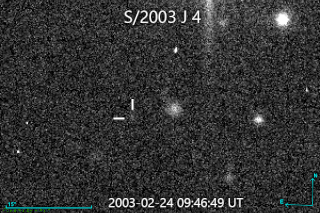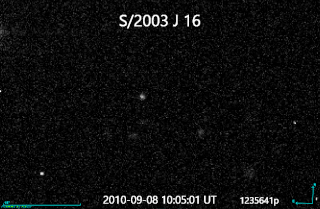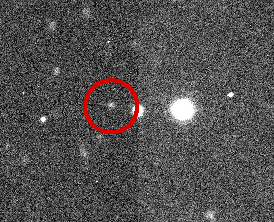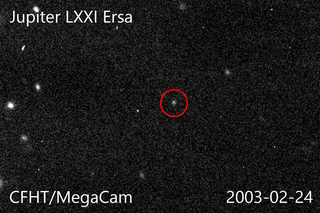Related Research Articles

Orthosie, also known as Jupiter XXXV, is a natural satellite of Jupiter. It was discovered by a team of astronomers from the University of Hawaii led by Scott S. Sheppard in 2001, and given the temporary designation S/2001 J 9.
Scott Sander Sheppard is an American astronomer and a discoverer of numerous moons, comets and minor planets in the outer Solar System.

S/2003 J 2 is a retrograde irregular satellite of Jupiter. The moon was discovered on 5 February 2003 by a team of astronomers from the University of Hawaii led by Scott S. Sheppard and David C. Jewitt, and was later announced on 4 March 2003. It was initially thought to be Jupiter's outermost known moon until recovery observations disproved this in 2020.

S/2003 J 4 is a natural satellite of Jupiter. It was discovered by a team of astronomers from the University of Hawaii led by Scott S. Sheppard in 2003.
Eirene, also Jupiter LVII and originally known as S/2003 J 5, is a retrograde irregular satellite of Jupiter. It was discovered by a team of astronomers from the University of Hawaii led by Scott S. Sheppard in 2003 but was then lost. It was recovered in 2017 and given its permanent designation that year.

S/2003 J 9 is a retrograde irregular satellite of Jupiter. It was discovered by a team of astronomers from the University of Hawaii led by Scott S. Sheppard in 2003.

S/2003 J 12 is a natural satellite of Jupiter, and is one of the smallest known natural satellites in the Solar System. It was discovered by a team of astronomers from the University of Hawaii led by Scott S. Sheppard in 2003.

S/2003 J 16 is a natural satellite of Jupiter. It was discovered by a team of astronomers led by Brett J. Gladman in 2003.

S/2003 J 23 is a natural satellite of Jupiter. It was discovered by a team of astronomers from the University of Hawaii led by Scott S. Sheppard et al. in 2004 from pictures taken in 2003.

Jupiter LIV, originally known as S/2016 J 1, is an outer natural satellite of Jupiter. It was discovered by Scott S. Sheppard in 2016, but not announced until June 2, 2017 via a Minor Planet Electronic Circular from the Minor Planet Center. It is about 1 kilometer in diameter and orbits at a semi-major axis of about 20,650,845 km with an inclination of about 139.8°. It belongs to the Ananke group.

Jupiter LIX, provisionally known as S/2017 J 1, is an outer natural satellite of Jupiter on a retrograde orbit. It was reported on June 5, 2017, via a Minor Planet Electronic Circular from the Minor Planet Center. It is believed to be about 2 km in diameter.

Valetudo, also known as Jupiter LXII and originally known as S/2016 J 2, is an irregular moon of Jupiter. It was discovered by Scott S. Sheppard and his team in data acquired by the 6.5-m Magellan-Baade telescope of the Las Campanas Observatory in 2016, but was not announced until 17 July 2018, via a Minor Planet Electronic Circular from the Minor Planet Center, which also reported the discovery of nine other of Jupiter's moons. Besides data from Las Campanas, the original announcement also referred to data acquired through the 8.1-m Gemini North telescope of the Mauna Kea Observatories as well as the 4.0-m reflector of the Cerro Tololo Inter-American Observatory.

Jupiter LXIII, provisionally known as S/2017 J 2, is an outer natural satellite of Jupiter. It was discovered by Scott S. Sheppard and his team in 2017, but not announced until July 17, 2018 via a Minor Planet Electronic Circular from the Minor Planet Center. It is about 2 kilometers in diameter and orbits at a semi-major axis of about 23,303,000 km with an inclination of about 166.4°. It belongs to the Carme group.

Jupiter LXIV, originally known as S/2017 J 3, is an outer natural satellite of Jupiter. It was discovered by Scott S. Sheppard and his team in 2017, but not announced until July 17, 2018 via a Minor Planet Electronic Circular from the Minor Planet Center. It is about 2 kilometers in diameter and orbits at a semi-major axis of about 20,694,000 km with an inclination of about 147.9°. It belongs to the Ananke group.

Ersa, also designated Jupiter LXXI, is a small outer natural satellite of Jupiter discovered by Scott S. Sheppard on 11 May 2018, using the 4.0-meter Víctor M. Blanco Telescope at Cerro Tololo Observatory, Chile. It was announced alongside nine other Jovian moons on 17 July 2018 and it provisionally designated S/2018 J 1 by the Minor Planet Center, after observations were collected over a long enough time span to confirm the satellite's orbit. The satellite has been found in precovery observations as early as 6 August 2000.

Pandia, also designated Jupiter LXV, is a small outer natural satellite of Jupiter discovered by Scott S. Sheppard on 11 May 2018, using the 4.0-meter Víctor M. Blanco Telescope at Cerro Tololo Observatory, Chile. It was announced alongside nine other Jovian moons on 17 July 2018 and it provisionally designated S/2017 J 4 by the Minor Planet Center, after observations were collected over a long enough time span to confirm the satellite's orbit. The satellite has been found in precovery observations as early as 2003.
Jupiter LXVII, originally known as S/2017 J 6, is an outer natural satellite of Jupiter. It was discovered by Scott S. Sheppard and his team in 2017, but not announced until July 17, 2018, via a Minor Planet Electronic Circular from the Minor Planet Center. It is about 2 kilometers in diameter and orbits at a semi-major axis of about 22,455,000 km with an inclination of about 155.2°. It belongs to the Pasiphae group.
Jupiter LXVIII, provisionally known as S/2017 J 7, is an outer natural satellite of Jupiter. It was discovered by Scott S. Sheppard and his team in 2017, but not announced until July 17, 2018, via a Minor Planet Electronic Circular from the Minor Planet Center. It is about 2 kilometers in diameter and orbits at a semi-major axis of about 20,627,000 km with an inclination of about 143.4°. It belongs to the Ananke group.
Jupiter LXX, originally known as S/2017 J 9, is an outer natural satellite of Jupiter. It was discovered by Scott S. Sheppard and his team in 2017, but not announced until July 17, 2018, via a Minor Planet Electronic Circular from the Minor Planet Center. It is about 3 kilometers in diameter and orbits at a semi-major axis of about 21,487,000 km with an inclination of about 152.7°. It belongs to the Ananke group.

Jupiter LXIX, originally known as S/2017 J 8, is an outer natural satellite of Jupiter. It was discovered by Scott S. Sheppard and his team in 2017, but not announced until July 17, 2018, via a Minor Planet Electronic Circular from the Minor Planet Center. It is about 1 kilometer in diameter and orbits at a semi-major axis of about 23,232,700 km with an inclination of about 164.7°. It belongs to the Carme group.
References
- 1 2 S.S. Sheppard (2019), Moons of Jupiter, Carnegie Science, on line
- ↑ "MPEC 2018-O13 : S/2017 J 5". Minor Planet Center. International Astronomical Union . Retrieved 17 July 2018.